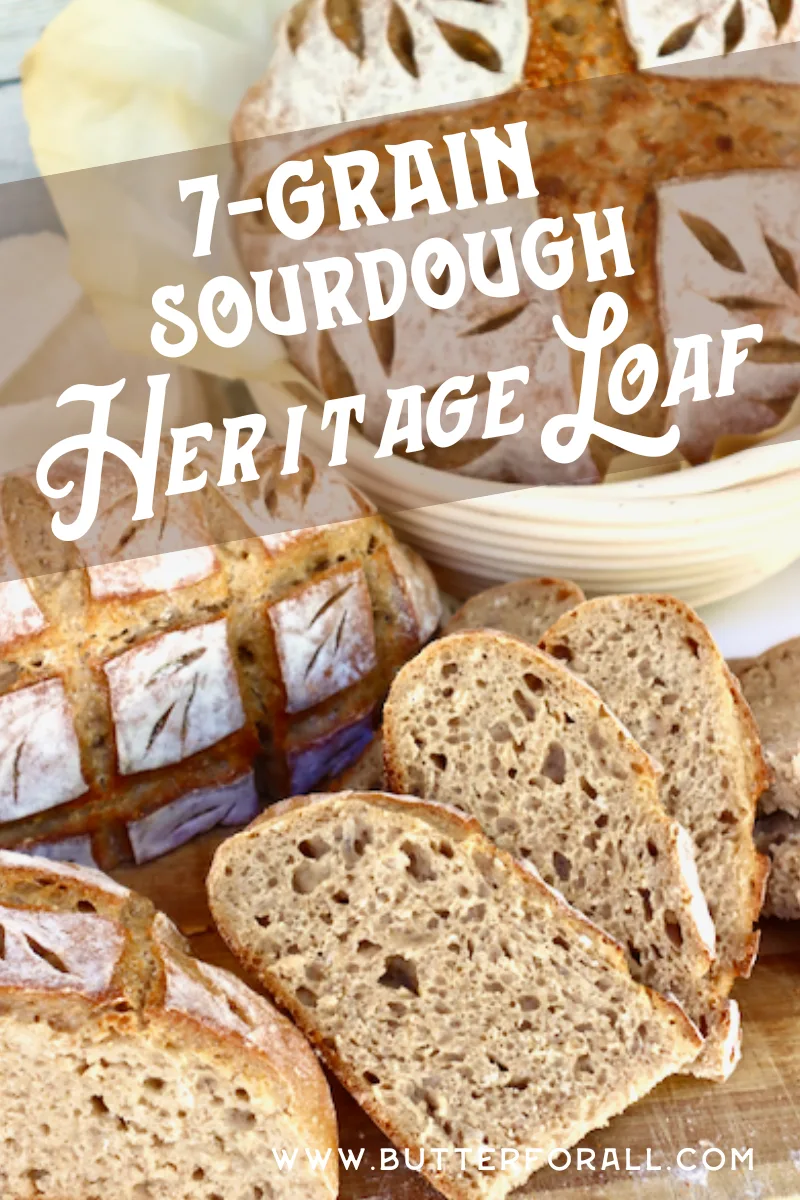This seven-grain sourdough recipe is the perfect blend of ancient and heirloom grains for a robust wheaty flavor and a hearty, chewy texture.
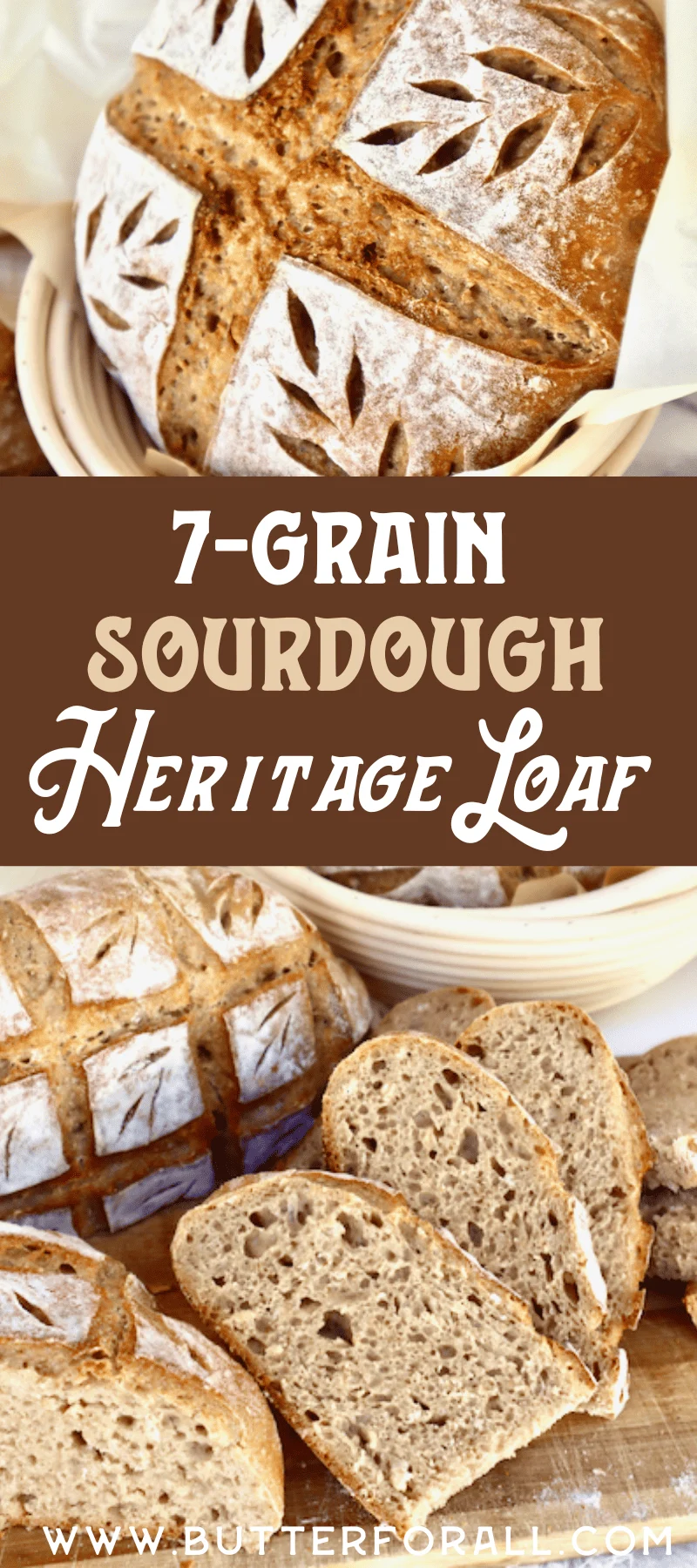
Master of the Grain
I used my sourdough master recipe as the basic ratio for this heritage loaf. I opted for 34% sifted hard red wheat flour to build strength and give a nice loft to the bread. The other 66% of the flour is a custom blend of six heirloom grains including ancient, nutty-flavored einkorn and buttery, golden Kamut (Khorasan).
I didn’t stop there with the flavor! The addition of rye, emmer, spelt, and rolled oats make this bread truly one of a kind.
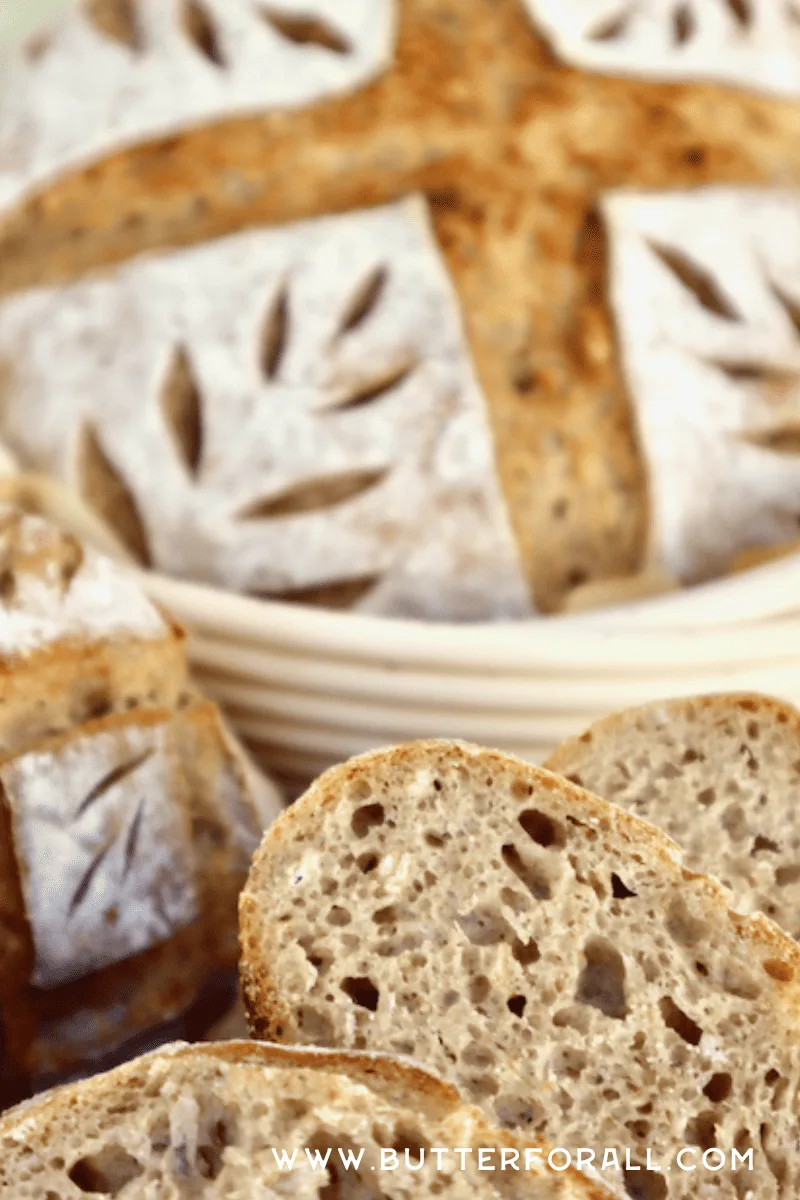
Mixing and Proofing
I like to mix this dough by hand, using a Danish dough whisk to start. Once the dough comes together I turn it out onto my floured work surface and knead it in 1- to 2-minute intervals to build strength and develop gluten. Between each kneading I let the dough rest for 5 to 10 minutes to keep the gluten from tearing or ripping.
If the smooth surface of the dough starts to tear it’s time to stop kneading and let the dough rest!
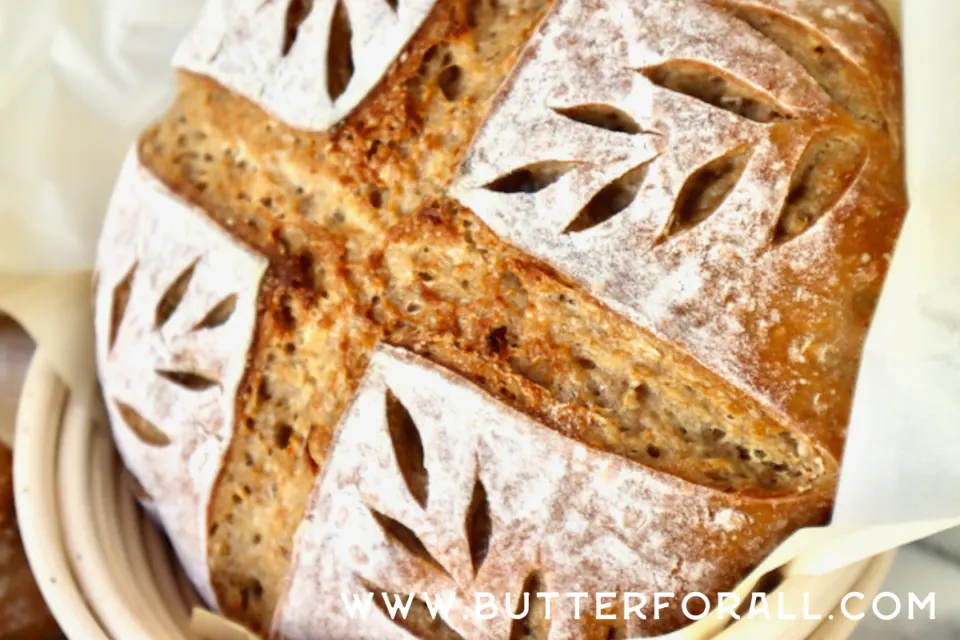
This dough proofs fairly quickly due to the high percentage of whole grain. In winter I can get away with an overnight bulk ferment at room temperature, but during summer months this dough needs to be kept cool if opting for a longer bulk ferment.
Longer ferments can be done in an ice chest with blue ice to keep the bread dough around 65℉. You can also start with a shorter (4-hour) room-temperature ferment followed by a refrigerator ferment for an additional 8 to 24 hours.
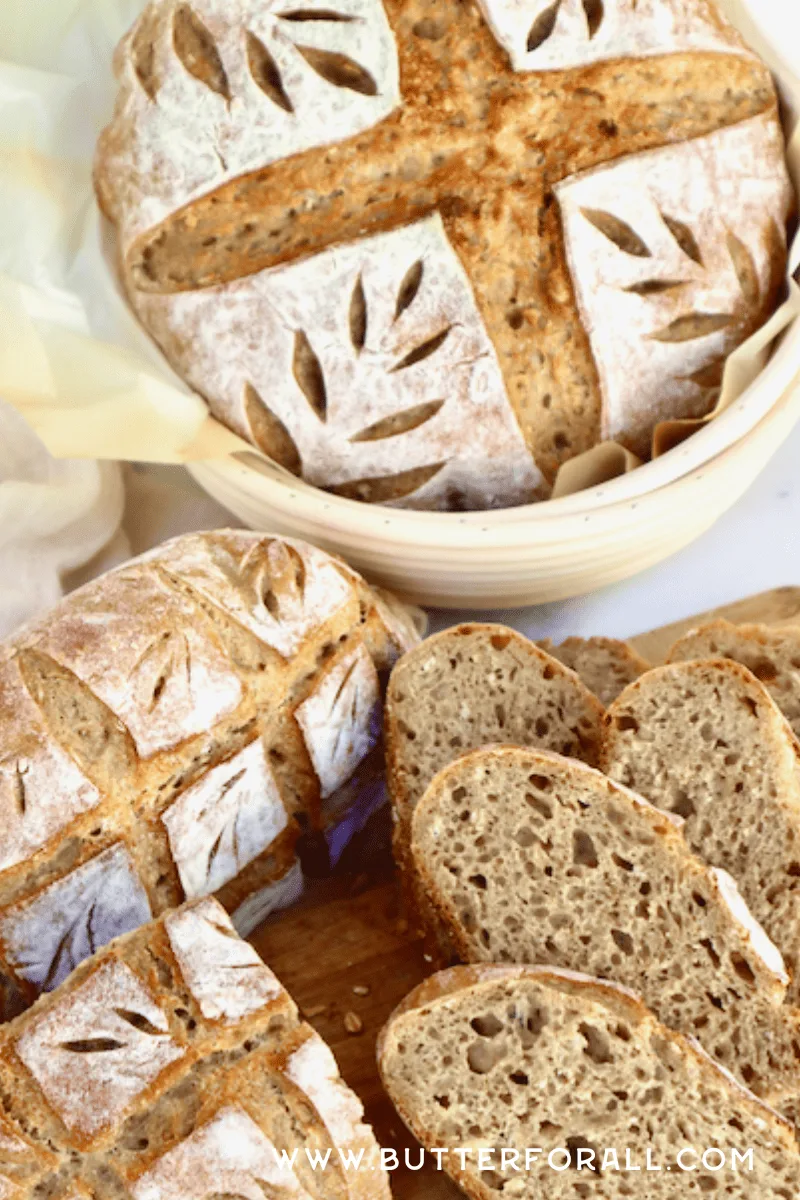
With a very active starter that doubles in less than 4 hours, this bread can be made in one day if you start early enough in the morning and bake in the evening. You can also try retarding the dough in the refrigerator after shaping to help with timing and increase flavor and digestibility.
As with all sourdough recipes, finding the timing that works for you and your starter is the most important ingredient!
Shaping and Baking
If you have developed a decent amount of gluten during kneading and it hasn’t over-proofed, shaping this dough is easy and enjoyable. I tend to shape the dough in a boule or batard style. You could also try this bread in a loaf pan or even shaped into hearty rolls.
I suggest baking this heritage bread for the first 25 minutes in a covered cast-iron Dutch oven or in a covered clay or enamel roasting pan to keep the crust soft and help with a nice oven spring (rise).
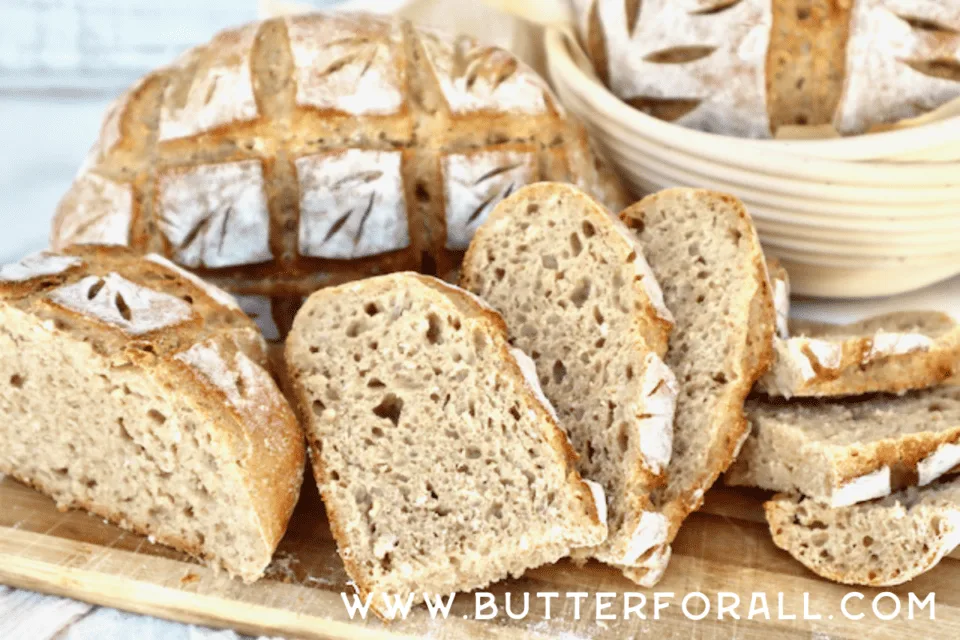
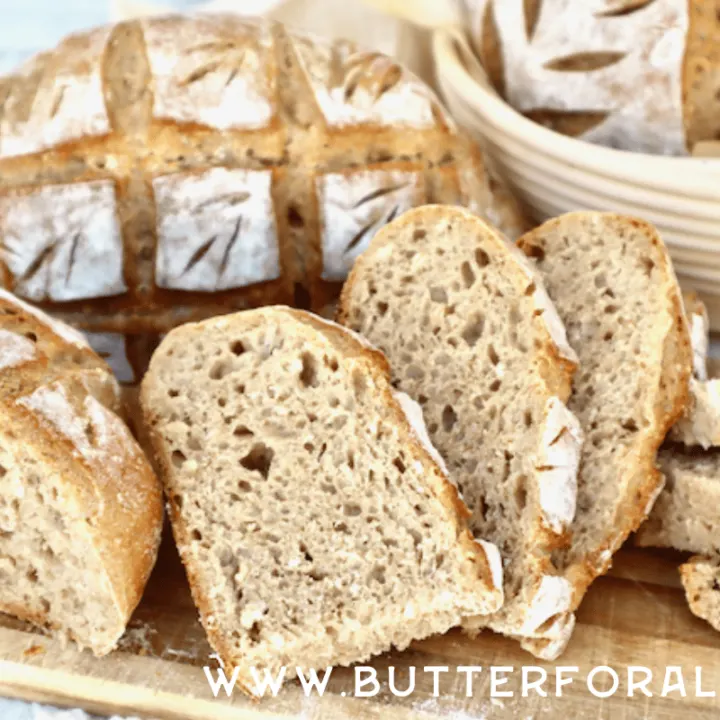
Seven-Grain Sourdough Heritage Loaf
This hearty seven-grain sourdough bread is packed with flavor and texture from a custom blend of ancient and heirloom graievenns.
Ingredients
- 155 grams organic sifted whole-wheat flour (hard red)
- 50 grams organic emmer flour
- 50 grams organic einkorn flour
- 50 grams organic spelt flour
- 50 grams organic Kamut flour
- 50 grams organic rye flour
- 50 grams organic rolled oats
- 296 grams water
- 125 grams starter
- 12 grams salt
Instructions
Mixing:
- In a medium-sized bowl combine the dry ingredients, including the salt, and mix well with a Danish dough whisk, silicon spatula, or wooden spoon.
- Measure the water and starter into the bowl and continue combining.
- Stir and fold the dough until it comes together in a solid mass.
- Let the dough rest for 5 minutes.
- Turn the dough out on a lightly floured work surface and knead the dough with a pulling and folding motion. Knead for a minute or two then let the dough rest for 5 to 10 minutes.
- Repeat this kneading process until the dough has developed a strong gluten network and has a bouncy elasticity when shaped into a ball.
Bulk Ferment:
- Place the dough ball back in the bowl, cover the bowl with a lid or plastic wrap, and allow it to bulk ferment until at least doubled. (Depending on what method you choose for your bulk ferment this process may take from 4 to 16 hours).
Shaping:
- Remove the fully proofed dough from the bowl onto a lightly floured work surface.
- Use a stretch and fold motion to deflate the dough and preshape it into a ball.
- Let the dough rest on the bench for 5 to 10 minutes.
- Gently shape the dough into a boule or batard and place it in a floured or linen-covered banneton. (Feel free to try other shapes as well!)
Final Proof:
- Cover the dough and let it double in size. This step can be done at room temperature or started at room temperature and finished in the refrigerator to extend the final proof and manage time.
Baking:
- Once the dough has doubled, preheat your oven to 450℉.
- Turn the dough out onto a square of parchment and score the top with a sharp razor blade (lame).
- Bake boules and batards covered for 25 minutes and uncovered for 15 more minutes. See notes for baking other shapes.
- Remove the bread from the oven when the crust is a deep golden brown and cool it completely on a wire rack before slicing.
Notes
Should I use whole-grain or all-purpose style flours?
Either! Or a combo of both. This recipe is really flexible.
The ancient and heirloom grains are there to add flavor and texture so my preference is to use freshly milled whole grain, but use what you have and what you can find.
The only thing to be aware of is the dough hydration. Different flour styles will likely need a touch more water or a touch more flour. The dough should be tacky and pliable at the right hydration. Not a sticky mess!
Substitutions:
The sifted whole-wheat flour can be replaced with all-purpose or bread flour. This will give the bread an even lighter texture.
Any of the heirloom ancient grains can be omitted and replaced by other wheat varieties in the recipe.
Just make sure the total flour adds up to 455 grams.
Shaping and Baking Other Styles:
Sandwich-style loaves and bread rolls should be baked uncovered on a lower oven rack at 400℉. Bake sandwich loaves for 30 to 35 minutes and rolls for 25 to 30 minutes.
Sourcing Ancient Grains:
Recommended Products
As an Amazon Associate and member of other affiliate programs, I earn from qualifying purchases.
-
 Square Premium Stoneware Baking Dish Handcrafted in Classic Black and White - 10 x 10 Great for Baking Rolls!
Square Premium Stoneware Baking Dish Handcrafted in Classic Black and White - 10 x 10 Great for Baking Rolls! -
 Le Creuset Stoneware Heritage Loaf Pan, 9" x 5" x 3"
Le Creuset Stoneware Heritage Loaf Pan, 9" x 5" x 3" -
 Salter Dual Pour Electronic Scale with Mixing Bowl,
Salter Dual Pour Electronic Scale with Mixing Bowl, -
 Pyrex 8-piece 100 Years Glass Mixing Bowl Set (Limited Edition)
Pyrex 8-piece 100 Years Glass Mixing Bowl Set (Limited Edition) -
 9 Inch Bread Banneton Proofing Basket - Baking Bowl
9 Inch Bread Banneton Proofing Basket - Baking Bowl -
 Oval (13,8 x 6,1 x 2.7 Inch) Bread Banneton Proofing Basket
Oval (13,8 x 6,1 x 2.7 Inch) Bread Banneton Proofing Basket -
 Danish Dough Whisk and Bread Lame Set Double Eye
Danish Dough Whisk and Bread Lame Set Double Eye -
 Lodge 5 Quart Cast Iron Dutch Oven. Pre-Seasoned Pot with Lid and Dual Loop Handle
Lodge 5 Quart Cast Iron Dutch Oven. Pre-Seasoned Pot with Lid and Dual Loop Handle
